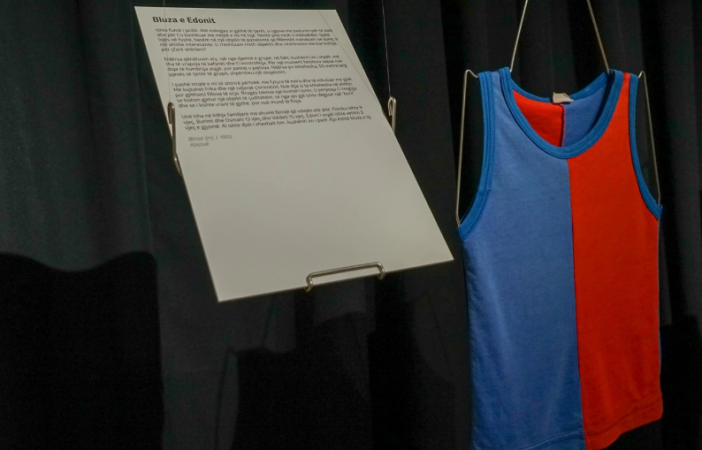[ad_1]
“I saw my friends lying on the ground, with their faces blackened and covered in blood. I did not know how to return home.”
This is the story of Blinor, a boy from Kosovo, born in 1993. He was not yet six years old when the 1998-’99 war in Kosovo began.
In April of ’99 he was playing on a field, when he and his friends encountered an explosive device. Blinori survived the blast, but five children were killed, including his cousin, Edon, 3.
Blinori has preserved the t-shirt that Edoni wore, which is now on display at the National Gallery of Art in Pristina, as part of the traveling exhibition of the Museum of Childhood of War.
Toys, drawings and clothes are just some of the things that children found in war zones, have preserved as a memory from the bloody years, which are now displayed in this exhibition.

Next to each exhibited object is a plaque with their story.
The exhibition, which opened on April 19 in Pristina, has collected stories from children from Kosovo, Bosnia and Herzegovina, Croatia, Serbia, Ukraine, Afghanistan, Syria, Iraq and the Palestinian territories.
The Museum of War Childhood was originally established in Sarajevo in 2017. Since then, it has been enriched with stories from wars in various countries and organizing traveling exhibitions from country to country, now including Kosovo.
The director of the Museum, Amina Kravavac, tells Radio Free Europe that they have tried to give space to the perspective of children, because often, according to her, they are not given a platform to express their needs and feelings from the war.
“The idea was to gather all the experiences and show that childhood affected by the war is a very complex social phenomenon. “We also try to emphasize the power of children,” says Kravavac.
The War Childhood Museum has collected the most stories and artifacts from children who experienced the war in Bosnia and Herzegovina during 1992-95.
Kravavac says that the stories of children from different areas of the world have different cultural, political and temporal contexts, but, according to her, they also have in common.
“In general, if we need a common denominator, we see how children really manage to create protective factors and mechanisms to cope with situations“, She says.
In November 1991, Martina, then about 3 years old, was hit by a grenade in Vinkovci, during the war in Croatia.
Her bloody blouse is preserved from the Museum of War Childhood.
In her confession, Martina has shown that her brother was also wounded in the head by that explosion.
In addition to objects and photographs, the exhibition has also collected video materials and recordings made at different times of the wars in the Balkans and beyond.
Renea, a girl from Kosovo, is heard confessing in a video shot in August 1999, about the burning of her house.
“I will do it [një shtëpi] new. Even better. By the pool“, Renea is heard in the video shot by her father. At that time, she was 8 years old.
According to the Humanitarian Law Center in Pristina, over 1,000 children were killed during the war in Kosovo. The attitude of children towards the war is one of the cleanest ways to tell experiences in the war, says Hajrie Gashi, who on Tuesday, April 19, visited the exhibition of the Museum of the Childhood of War in Prishtina.
Born in 2003, Hajria did not experience the war in Kosovo, but says that the children’s stories moved her a lot.
“I’m speechless. It’s just pure the way they show it [fëmijët]how they experienced it [luftën] in their world, how they saw it…“, Says Hajria.
Although the theme of the war remains sensitive many years later, Kravavac says exhibitions of these stories were well received in Sarajevo, Belgrade and Pristina.
“We felt very welcome and saw that people were thankful that someone was dealing with the topic of war from a new and somewhat innovative perspective“, She says. Nacibi, a boy now living in Bosnia and Herzegovina, witnessed his parents being killed by a Taliban bomb planted in Afghanistan in 2009.
The Taliban, a militant group, was ousted from power in 2001. For 20 years until their return to power, in 2021 they fought with government forces.
Nachib has told the story of his parents and has preserved his father’s rosary. In eastern Ukraine, pro-Russian separatists have been fighting government forces since 2014. As of February 24 this year, Russia has launched a large-scale occupation of Ukraine.
More than 13,200 people are believed to have been killed in fighting in the east for more than eight years.
Dmytro, a boy born in 2002, has donated a toy dog to the War Childhood Museum.
On a date not made public in Dmytro’s confession, after the conflict began in 2014, he was in his backyard when he heard gunshots. A bullet hit his toy dog, rescuing him from injury.
“The bullet caused holes in my dog’s body, but we sewed them up quickly and he has been like my best friend ever since. “I could trust everything, even my biggest fear.”Dmytro confessed.
The exhibition in Prishtina, with these and other children’s stories, will be open until April 30.
After that date, according to the executive director of the Museum of Childhood War, Amina Kravavac, the exhibition will travel to other European countries, but has not specified where.
top channel
[ad_2]
Source link















